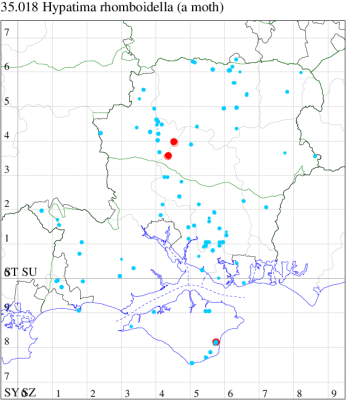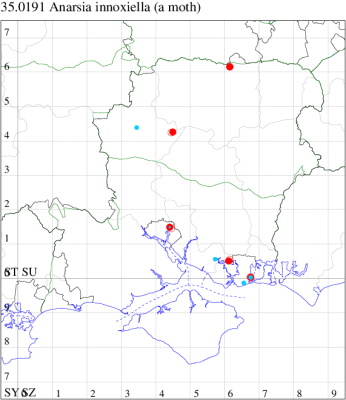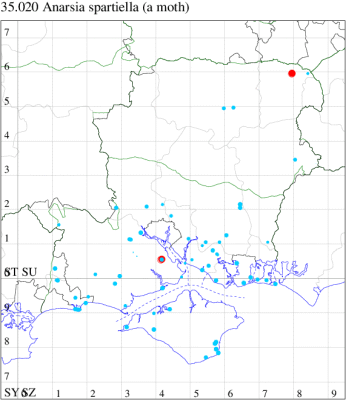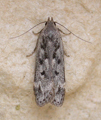2020 Annual Report for: Gelechiidae / Anacampsinae
For species seen in 2020 that had less than or equal to 100 records, full details are included; for more common species, the earliest, latest and highest count by vice-county are shown. The narrative for each species is taken from the main Hantsmoths website, and it is possible that some information on abundance and occurrence can get out of date, as it is impossible to keep up with all changes; however it should give a good introduction to each species. The tables in each species account summarise the previous status, and that for the current year.
For the maps, all records prior to 2020 are shown by a blue dot (the larger the dot, the more recent), with the current year's records shown in red. As previous records are superimposed on any report for 2020, new sites have greater emphasis (i.e. will show as 'more red').
In the species accounts, an asterisk next to a location indicates a new 10km square record; earliest ever dates are highlighted in orange, and latest ever in red. Initials in the species accounts refer to the recorders listed here. Please get in touch if you identify any omissions or errors, in particular if you have records that have yet to be submitted. Details of how to submit records can be found here.
35.003 [B&F: 0844] Aproaerema larseniella (Gozmány, 1957) - Local
Local in rough ground and damp open areas throughout much of southern and eastern England. In south Hampshire, first recorded from Wickham in 1975, and subsequently from Ashurst, Ampfield and Botley Wood; in north Hampshire, first recorded in Selborne in 1996; subsequently, found to be relatively widespread across the county, and doubtless under-recorded in some areas, but not recorded on the Isle of Wight to date. Wingspan 11-14 mm. The most likely confusion species are S. cinctella and S. taeniolella, which see for differences. Larva feeds on Greater Bird's-foot Trefoil, living between leaves spun together with silk.
Records prior to 2020
| Vice County | #Records | #Individuals | First Record | Last Record |
|---|---|---|---|---|
| 10 | 1 | 1 | 2011 | 2011 |
| 11 | 99 | 92 | 1973 | 2019 |
| 12 | 29 | 41 | 1994 | 2019 |
2020 records
| Vice County | #Records | #Individuals | Max Quantity |
|---|---|---|---|
| 11 | 2 | 2 | 1 |
Records by year
Records by week (adult)
Records by week (larval)
Record Details
VC11: Marchwood, one, 14 Jul (CTh); Stockbridge Down NT, one, to actinic, 24 Jul (GCE);
VC12: Eversley, one, netted, ♂ gen det, 18 Jun; one, netted, ♂ gen.det., 18 Jun (JHH det. AMD); Long Valley, Fleet, one, netted, ♂ gen det, 17 Jun; one, netted, ♂ gen.det., 17 Jun (JHH, AMD det. AMD)
35.004 [B&F: 0847] Aproaerema taeniolella (Zeller, 1839) - Local
Local on rough ground in England, south of a line from Shropshire to the Wash, becoming less common northwards; rarely in Wales, Scotland and Ireland. In Hampshire recorded in both vice-counties, sometimes commonly; on the Isle of Wight, although it almost certainly still occurs there, no recent record has been received. Wingspan 11-14 mm. The most likely confusion species are S. larseniella and S. cinctella, neither of which has a fascia on the underside of the forewing nor a costal spot on the underside of the hindwing (MBGBI Vol 4 part 2). Larva feeds on Bird's-foot Trefoil, Clover, Black Medick and Spotted Medick, living between leaves spun together with silk.
Records prior to 2020
| Vice County | #Records | #Individuals | First Record | Last Record |
|---|---|---|---|---|
| 10 | 15 | 25 | 1900 | 2018 |
| 11 | 40 | 23 | 1973 | 2018 |
| 12 | 12 | 15 | 1985 | 2011 |
2020 records
| Vice County | #Records | #Individuals | Max Quantity |
|---|---|---|---|
| 10 | 2 | 2 | 1 |
| 12 | 5 | 6 | 2 |
Records by year
Records by week (adult)
Records by week (larval)
Record Details
VC10: Upper Ventnor, one, swept, 06 Jul; Bembridge Fort*, one, 06 Aug (IOu)
35.010 [B&F: 0843] Aproaerema anthyllidella (Hübner, [1813]) - Local
Local on rough grassland and dry pastures throughout much of the British Isles. In Hampshire and on the Isle of Wight fairly common and widely recorded, especially on the south coast, but like many species, doubtless under-recorded in the north-west of the county; the lack of records from the New Forest may, however, be a genuine reflection of the species' status there. Apart from one record from Noar Hill in 1975, it was unknown in north Hampshire until 2003, when single individuals were recorded in Pamber Forest and Basingstoke, since when increasingly recorded in the north of the county. Wingspan 10-12 mm. The most likely confusion species are Eulamprotes immaculatella and Syncopacma albipalpella, which see for differences. Larva mines leaves of Kidney Vetch, Red Clover, White Clover, Common Restharrow, Sainfoin and Lucerne, subsequently feeding on the flowers and seeds.
Records prior to 2020
| Vice County | #Records | #Individuals | First Record | Last Record |
|---|---|---|---|---|
| 10 | 30 | 43 | 1850 | 2018 |
| 11 | 179 | 188 | 1975 | 2019 |
| 12 | 36 | 54 | 1975 | 2019 |
2020 records
| Vice County | #Records | #Individuals | Max Quantity |
|---|---|---|---|
| 10 | 7 | 7 | 1 |
| 11 | 12 | 13 | 2 |
| 12 | 3 | 3 | 1 |

Records by year
Records by week (adult)
Records by week (larval)
Record Details
VC10: Freshwater, one, to actinic, gen det, 12 Sep (PBa); Windy Corner*, one, 14 Sep; Shanklin, one, gen det, 26 May; one, 25 Jun; one, 30 Jul; one, 14 Sep; one, 15 Sep (IOu);
VC11: Allbrook, one, 17 Aug (SI); Fareham, one, to actinic, gen det, 28 Sep (MLO det. RJD); Portsmouth, one, gen det, 27 May; one, 24 Jun; one, 17 Jul; one, 21 Jul; two, 08 Aug; one, 12 Aug; one, 18 Aug; one, 01 Sep; one, 07 Sep; one, 13 Sep (IRT);
VC12: Cholderton, one, 24 Jul; one, 31 Jul; two, 08 Aug (TJN, HE); Preston Candover*, one, 07 Aug (MJW); Pamber Forest, one, 13 Jul; one, 31 Jul (GJD)
35.011 [B&F: 0853] Anacampsis populella Clerck, 1759 - Common
Common in a wide range of habitats throughout much of Britain, but appears to be absent from the whole of southern Scotland (MBGBI Vol 4 part 2). In Hampshire common and widespread, rather less common on the Isle of Wight, with only one recent record, at Cranmore in 2006. Wingspan 14-19 mm. Very variable with range of coloration and basic pattern the same as A. blattariella from which it can be reliably separated only by dissection of the genitalia, although the less strongly angled fascia (when visible) allows tentative identification (MBGBI Vol 4 part 2). Larva feeds on Poplar, Aspen and Willow, living within a spun or rolled leaf.
Records prior to 2020
| Vice County | #Records | #Individuals | First Record | Last Record |
|---|---|---|---|---|
| 10 | 13 | 1 | 1893 | 2019 |
| 11 | 160 | 126 | 1970 | 2019 |
| 12 | 30 | 44 | 1976 | 2019 |
2020 records
| Vice County | #Records | #Individuals | Max Quantity |
|---|---|---|---|
| 10 | 2 | 3 | 2 |
| 11 | 5 | 6 | 2 |
| 12 | 1 | 1 | 1 |

Records by year
Records by week (adult)
Records by week (larval)
Record Details
VC10: Brook, one, gen det, 16 Jul; Haseley Manor, two, gen det, 11 Aug (IOu);
VC11: Ashley, one, to actinic, 22 Jul; Stockbridge Down NT, two, to actinic, 24 Jul; Kings Somborne, one, to actinic, 07 Aug (GCE); Twyford, one, netted, 26 May (RJD); Kings Somborne*, one, to actinic, 07 Aug (GCE);
VC12: Pamber Forest, one, 07 Sep (GJD)
35.012 [B&F: 0854] Anacampsis blattariella (Hübner, 1796) - Local
Local in heathland and woodland throughout much of England. Fairly widely recorded across much of Hampshire, but not particularly common, and remaining very rare on the Isle of Wight. Wingspan 16-19 mm. Can be differentiated with certainty from A. populella only by the structure of the genitalia and the larval foodplant, although the more strongly angled fascia (when visible) allows tentative identification (MBGBI Vol 4 part 2). Larva feeds on Birch, living within a spun or rolled leaf.
Records prior to 2020
| Vice County | #Records | #Individuals | First Record | Last Record |
|---|---|---|---|---|
| 10 | 2 | 1 | 1995 | 2011 |
| 11 | 77 | 68 | 1976 | 2019 |
| 12 | 51 | 99 | 1976 | 2018 |
2020 records
| Vice County | #Records | #Individuals | Max Quantity |
|---|---|---|---|
| 11 | 7 | 13 | 7 |
| 12 | 9 | 12 | 4 |

Records by year
Records by week (adult)
Records by week (larval)
Record Details
VC11: Kings Somborne, one, to actinic, 31 Jul; one, to actinic, 31 Jul; one, to actinic, 31 Jul; seven, to actinic, 31 Jul; one, to actinic, 31 Jul (GCE); Dibden Purlieu, one, to actinic, 09 Aug (RAC); West Meon*, one, 31 Jul (F.M.G.);
VC12: Harewood Forest, one, to actinic, 23 Jul; one, to actinic, 23 Jul; one, to actinic, 24 Jun; one, to actinic, 23 Jul; Chilbolton, one, to actinic, 15 Sep; Barton Stacey, one, to actinic, 11 Aug; one, to actinic, 16 Jul; four, to actinic, 16 Jul; one, to actinic, 11 Aug (GCE)
35.017 [B&F: 0797] Neofaculta ericetella (Geyer, [1832]) - Common
Common on heathland and moorland, also in gardens where heather is grown, throughout much of the British Isles. In Hampshire common on heathy ground, especially in the New Forest and on the heaths in the north-east of the county. On the Isle of Wight, only recorded in recent years from Headon Warren and Cranmore. Wingspan 15-18 mm. Larva feeds on flowers of Heather, Bell Heather and Cross-leaved Heath, subsequently living within a silken web.
Records prior to 2020
| Vice County | #Records | #Individuals | First Record | Last Record |
|---|---|---|---|---|
| 10 | 17 | 59 | 1890 | 2016 |
| 11 | 144 | 593 | 1972 | 2019 |
| 12 | 73 | 177 | 1974 | 2018 |
2020 records
| Vice County | #Records | #Individuals | Max Quantity |
|---|---|---|---|
| 11 | 1 | 1 | 1 |
| 12 | 12 | 33 | 12 |

Records by year
Records by week (adult)
Records by week (larval)
Record Details
VC11: Acres Down, one, 08 Aug (CWlk);
VC12: Basingstoke, one, 01 Jun; one, 24 Jun; two, 16 Jul; one, 21 Jul; six, 23 Jul; one, 29 Jul; 12, 31 Jul; two, 06 Aug; four, 08 Aug (RHil); Liss Forest*, one, 10 May (RJM); Whitehill, one, to actinic, 21 May (ASto); Castle Bottom NNR, present, 25 Jun (JHH, AMD); Farnborough, one, 23 Jun (KBW); Yateley*, one, 19 May; one, 27 May; four, 21 May; one, 09 Jun (JHH)
35.018 [B&F: 0858] Hypatima rhomboidella (Linnaeus, 1758) - Common
Common in woodland, heathland and scrub throughout the British Isles. The distribution in Hampshire mirrors those areas in which trapping effort is concentrated, and the moth is probably more widely distributed than the records suggest; very infrequently recorded from the Isle of Wight. Wingspan 15-19 mm. Superficially resembles the far more widespread and common Scrobipalpa costella, but H. rhomboidella is larger and has characteristic short, black, apical line. Larva feeds on Birch and Hazel, living within a spun or rolled leaf.
Records prior to 2020
| Vice County | #Records | #Individuals | First Record | Last Record |
|---|---|---|---|---|
| 10 | 54 | 64 | 1893 | 2019 |
| 11 | 91 | 98 | 1971 | 2019 |
| 12 | 64 | 76 | 1976 | 2018 |
2020 records
| Vice County | #Records | #Individuals | Max Quantity |
|---|---|---|---|
| 10 | 2 | 2 | 1 |
| 12 | 2 | 2 | 1 |

Records by year
Records by week (adult)
Records by week (larval)
Record Details
VC10: Shanklin, one, 02 Aug; one, 18 Oct (IOu);
VC12: Crawley, one, to actinic, 12 Aug; Barton Stacey, one, to actinic, 14 Aug (GCE)
35.0191 [B&F: 0857a] Anarsia innoxiella Gregersen & Karsholt, 2017 - Rare
A recently identified resident species, the larvae feeding on Acer species.
In Ent Rec J Var 129 (2017) a paper was published introducing Anarsia innoxiella as a species new to science, separated from the adventive A. lineatella.
Since the separation of the two species, a number of records of A. innoxiella were discovered in southern England, and in our area it is reasonably widespread in Hampshire and was taken on Isle of Wight for the first time in 2021.
Most historic light-trapped specimens of the lineatella / innoxiella pair are most likely to refer to the latter, but this is by no means a hard and fast rule as there has been at least one specimen of the former at light (Dorset, 2003). Historic records without a supporting photo or specimen cannot be confirmed.
Distinguishable from A. lineatella by having a broadly longitudinal black spot followed by white in the middle of the wing (A. innoxiella has a straighter black streak in this area), but there is variation in both species. For other distinguishing features, see Ent Rec 129: 118.
Updated: July 2019 (taxonomic status)
Records prior to 2020
| Vice County | #Records | #Individuals | First Record | Last Record |
|---|---|---|---|---|
| 11 | 26 | 33 | 2006 | 2019 |
| 12 | 2 | 2 | 2018 | 2019 |
2020 records
| Vice County | #Records | #Individuals | Max Quantity |
|---|---|---|---|
| 11 | 8 | 10 | 3 |
| 12 | 2 | 2 | 1 |

Records by year
Records by week (adult)
Records by week (larval)
Record Details
VC11: Southampton, one, to actinic, 24 Jun; one, to actinic, 01 Jul; one, to actinic, 11 Jul; one, to actinic, 12 Jul; three, to actinic, 17 Jul (MGP); Chandlers Ford*, one, 09 Jun; one, 09 Jun (BE); Portchester, one, field observation, 28 Jun (DAS); one, 27 Jun (JS); Portsmouth, one, 25 Jun; one, 26 Jun (IRT);
VC12: Barton Stacey*, one, to actinic, photograph taken., 16 Jul (GCE); Pamber Forest*, one, 25 Jun (GJD)
35.020 [B&F: 0856] Anarsia spartiella (Schrank, 1802) - Local
Local on heathland, downland and waste ground throughout much of the British Isles. In Hampshire locally common in the south of the county, with the few records in the north-east at Yately, Bramshott and Ludshott Commons and in the Deadwater Valley. On the Isle of Wight, the only record since 1975, when found on Tennyson Down, is from Cranmore in 2004. Wingspan 12-15 mm. The female has long, exposed labial palps, which protrude conspicuously from the labial scale tufts. Larva feeds on shoots of Gorse, Broom and Dyer's Greenweed, living within a spinning.
Records prior to 2020
| Vice County | #Records | #Individuals | First Record | Last Record |
|---|---|---|---|---|
| 10 | 22 | 21 | 1899 | 2019 |
| 11 | 129 | 156 | 1965 | 2019 |
| 12 | 9 | 10 | 1977 | 2010 |
2020 records
| Vice County | #Records | #Individuals | Max Quantity |
|---|---|---|---|
| 11 | 1 | 1 | 1 |

Records by year
Records by week (adult)
Records by week (larval)
Record Details
VC11: Dibden Purlieu, one, to actinic, 25 Jun (RAC); Sway, one, 25 Jun (SKe);
VC12: Castle Bottom NNR*, one, netted, ♂ gen det, 15 Jun (JHH det. AMD)
()(IMG_5373).jpg)



